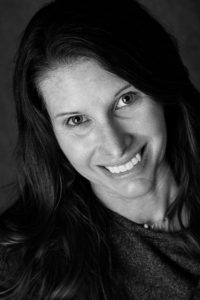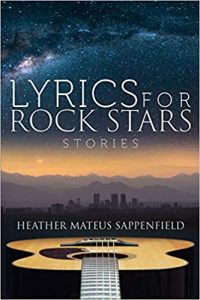LISTENING WITH COURAGE: HOW I NAVIGATE BETWEEN MIDDLE-GRADE, YA, AND ADULT WRITING
By Heather Mateus Sappenfield
 I write a story listening carefully to how it needs to be told, regardless of genre. Its narrator usually ushers a tale from what seems the back to the front of my noggin, and it tends—unlike most folks—to arrive in near entirety, with all the big movements in place. The details are where the surprises occur. I then let the story park in my mind, cued, and while it’s there, I gauge its heft, trace its edges, sense its threads of connection to readers. These elements determine the type of book it will be, not the other way around.
I write a story listening carefully to how it needs to be told, regardless of genre. Its narrator usually ushers a tale from what seems the back to the front of my noggin, and it tends—unlike most folks—to arrive in near entirety, with all the big movements in place. The details are where the surprises occur. I then let the story park in my mind, cued, and while it’s there, I gauge its heft, trace its edges, sense its threads of connection to readers. These elements determine the type of book it will be, not the other way around.
As a dyslexic, I approach much of life in directions that deviate from the norm. Yet I had to learn to trust this listening the hard way. We writers all have our own methods, but I’ll share my journey now in hope it might assist you.
Early on, after completing my MFA, I published two young-adult novels in quick succession. I had an agent who specialized in that genre, so, of course, she wanted me to continue producing YA. But writing stories aimed toward a genre deafened me to my process, and my work became hollow junk.
Panning the new books I wrote, my agent dumped me. I grew disillusioned. The business seemed too hard, too dehumanizing, too much about marketing trends and earning a buck. I quit writing.
While I pondered career choices, I rooted around in my shadows, taking a long unflinching look at myself, and I emerged with this kernel of truth: connecting with readers is my writer’s purpose, any themes or “art” arises organically from that, and where I’d gone astray was in my motivation. I returned to the craft, focusing, not on results, but on the purity of that connection. And you know what? The stories began whispering again. After having sprinted down the traditional publishing lane, this approach felt bold, precarious, impractical, yet, even as a Colorado Book Awards Finalist, I hadn’t made any real income, so what did I have to lose?
Each writer’s process is theirs alone, and I applaud anyone who has the fortitude to write a book. But I’ve learned that stories thrive when I write them from a place of mindful listening, with no attachment to the fruits of my labors. In fact, my focus lies in rooting myself right out of them, clear down to weighing each word, ensuring it advances only the narration. Yes, I’m creating a fictional world, thus guiding readers, but often we writers insert a layer comprised of our hang-ups.
That layer hinders how we structure a scene, tiptoe around a word, shape a character, hedge or even avoid an outcome. Once you start recognizing this, it’s startling how often we writers do this. When a word is pure and functioning in multiple ways—for instance, conveying action while simultaneously implying character, fortifying theme, and sounding succulent—I know everything is working.
This process animates my writing, giving it a palpable urgency and pulse. In allowing the story to breathe on its own, I hope to gift the reader space to form their own inferences, to have an experience of the book free of manipulation. Allowing a reader this sense of ownership is, for me, true craftsmanship. When I find myself holding back, often accompanied by a slight bracing of my body and a constriction of my mind, it’s a red flag to look closer and dig deeper. Sometimes I unearth less than flattering realizations about myself. It takes courage.
Now let’s address genre: there’s middle grade, young adult, new adult, upmarket, women’s fiction, literary, thriller, mystery, fantasy, I could go on and on. They’ve been created to assist the industry in guiding readers to books. For me, writing according to them is putting the cart before the horse. After the book is well underway, even a complete draft, I then determine its genre.
It’s easy to tumble into stereotypes, forgetting each genre is simply a guide to an experience. And within each of these genres reside different types of books. For example, in middle grade there’s everything from the graphic novels series Captain Underpants and Dog Man to more literary novels like A Monster Calls, The Underneath, or Because of Winn Dixie. Each of these books is written for a type of experience within that genre.
Readers tend to favor one of these types, often for life. My favorite books span multiple genres; their commonality lies in strong writing that leans toward literary. That’s the type of reader I am, no matter the genre. Thus, I’m also that type of writer. I might crave a reading experience where I’m in the moment with a young character (middle-grade or YA), or reflecting back on those years (adult), or fully in the adult world.
A middle-grade book will be no less complex than an adult one, rather it will be written at an appropriate reading and comprehension level. For example, a middle-grade novel will likely have simpler vocabulary and sentence structures and characters facing concerns/conflicts pertinent to that age. Inferential moments are necessary for these developing readers, but should be clearly drawn.
During the middle-grade years (ages 9-12), kids look outside themselves for the first time to understand how the world works. YA books (ages 12-19) look inward, asking, Who am I within this world, and what does that mean? The writing is not dumbed-down, rather it’s tailored to its audience. The younger the reader I’m writing for, the harder the work to weed out my adult perspectives, ways of speaking, and agendas.
In the end, whether I love a book I’m reading boils down to how well the author listened its formative whispers, and, ultimately, if they had the courage to allow the story to breathe on its own.
—
HEATHER MATEUS SAPPENFIELD: Heather Mateus Sappenfield’s writing explores the adventures that fill life, often in the Rocky Mountain landscape that has been her lifelong home. She’s fascinated by the many selves each of us becomes in our varied roles throughout the day (some we like, some we do not), and her writing often delves into the internal adventure of juggling those multiple selves.
Among the many recognitions her fiction has received are the Danahy Fiction Prize, the Arthur Edelstein Prize, three Pushcart Prize nominations, and finalist for the Flannery O’Connor Award, the Kraken Prize, and the Colorado Book Awards. “Lyrics for Rock Stars” is her first short story collection. To learn more about her life and work, visit: https://
LYRICS FOR ROCK STARS
 This prize-winning collection brings to life skiers, ranchers, cyclists, suffragettes, tourists, super models, dead pigs, burro racers, religious beet farmers, immigrant miners, scorned lovers, penitent centenarians, and musicians.
This prize-winning collection brings to life skiers, ranchers, cyclists, suffragettes, tourists, super models, dead pigs, burro racers, religious beet farmers, immigrant miners, scorned lovers, penitent centenarians, and musicians.
Some historical, some contemporary, its stories revel in their Western settings, as varied as the region’s landscape. Yet each story explores the ways society’s values clash with our individual desires, compelling us, despite tears or laughter, to weave our lives through these opposing forces, often creating not a lifeline, but a noose.
Category: How To and Tips






























